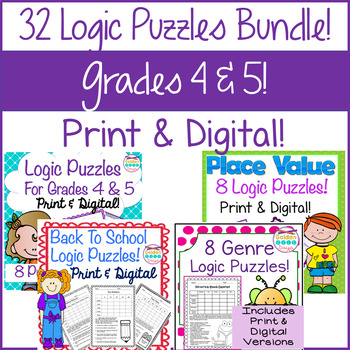32 Logic Puzzles Bundle Enrichment Activities Fast Finishers Print Digital
- Zip
- Google Apps™

What educators are saying
Products in this Bundle (4)
Description
Are you looking for ways to incorporate critical thinking into your classroom? These 32 Place Value, Back To School, Book Genres & General Logic Puzzles would be perfect for as enrichment activities and for fast finishers and gifted & talented students! They would also work well as morning work and homework.
All logic puzzles can be solved by reading the clues. In my third grade class, I introduced logic puzzles by doing one as a whole group. Then I let them work on one with a partner. Finally, I let them try them on their own. They love these!
Your gifted and talented students will probably figure these out after an introductory lesson on how they work.
I have included general directions for solving logic puzzles as well as step by step solutions for each puzzle.





